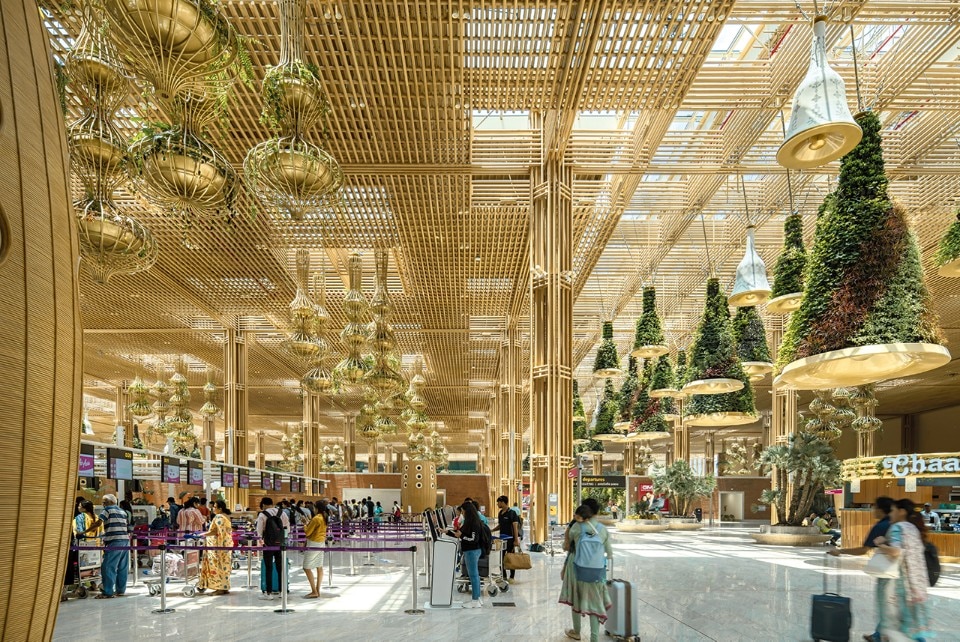The brief was deceptively simple: “a terminal in a garden.” Not just limited areas of plantings inside a terminal, but the perception that the new large terminal needed to meet steadily growing demand at the airport of India’s tech capital sits in a garden.
And the question of FOD – Foreign Object Damage, plant material blown into the aircraft aprons? “Prevent it.” Watering the plants? “Provide it, sustainably.” And maintenance? “Minimize it.” A challenge indeed. Bengaluru (formerly Bangalore) had been known as “the Garden City of India” for its network of boulevards overhung by magnificent shade trees and its sprawling public parks. Cubbon Park and Lalbagh are in effect botanical gardens, planted with exotic species of trees and bushes from across the world.
The climate of Bengaluru, the capital of Karnataka State in South India, is benign and very receptive to plants of many climates, tropical, subtropical, and more temperate.
There are almost 10,000 sqm of garden walls, 800 one-year old trees nurtured on-site ahead of the opening, 620 endemic plants and 7,700 transplanted ones.
The notion of a terminal in a garden was soon paired with another, seemingly in opposition. Bengaluru has more recently established itself as a major tech center, with numerous Indian and multi-national companies employing thousands, many graduates of the prestigious Indian Institute of Technology in Bengaluru. Nature and technology – were in the client’s brief to be the two sides of a proposed Indian and Karnatakan identity.
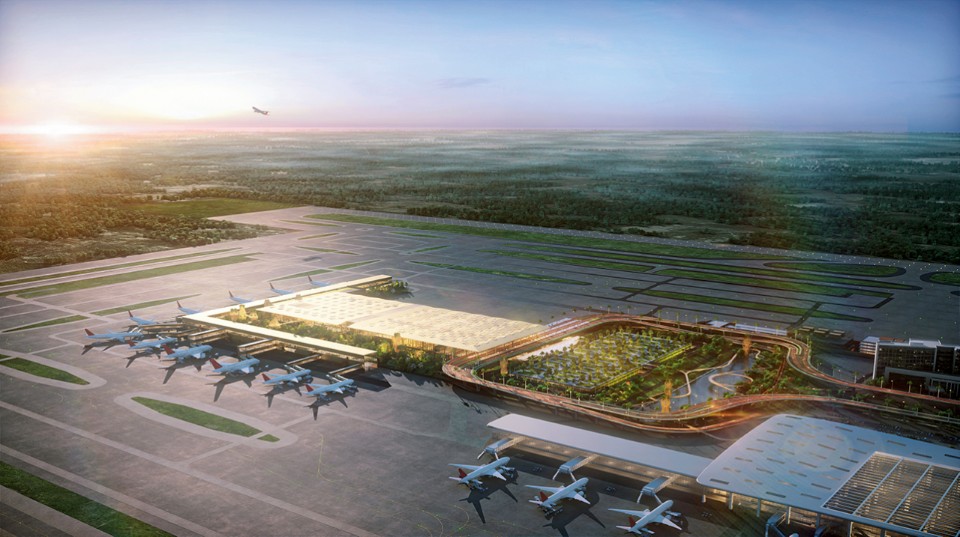
The new terminal must capture that duality. BIAL had hired Grant Associates to work with SOM in achieving this vision. Grant had recently completed portions of Gardens by the Bay in Singapore, and other impressive projects.
The prominence of technology’s role in the new terminal was assured by global, national and local developments in the aviation industry. BIAL was implementing a full range of self-processing equipment in Terminal 1 in an effort to extend its capacity long enough for Terminal 2 to be constructed. On the other hand, the city’s image of itself as the Garden City was threatened with long tracts of the shade trees being felled by development and road widening.
Was the “Terminal in a Garden” to be an exercise in nostalgia and replication of a disappearing legacy? And would there be any concerns that much of the city’s green streets and public spaces are part of a pervasive colonial legacy? That was not BIAL’s intention, and certainly not our reflex as architects. However, what meanings or messages was the concept intended to convey? Certainly, there were other contemporary design trends – wellness, biophilia, biomimicry and the like - but were these intended to be monumentalized in the new terminal? Along with nostalgia and replication, these current causes seemed too flimsy to carry the potential meanings of the terminal. Several precedents are worth considering when gauging what might be distinctive about Terminal 2.
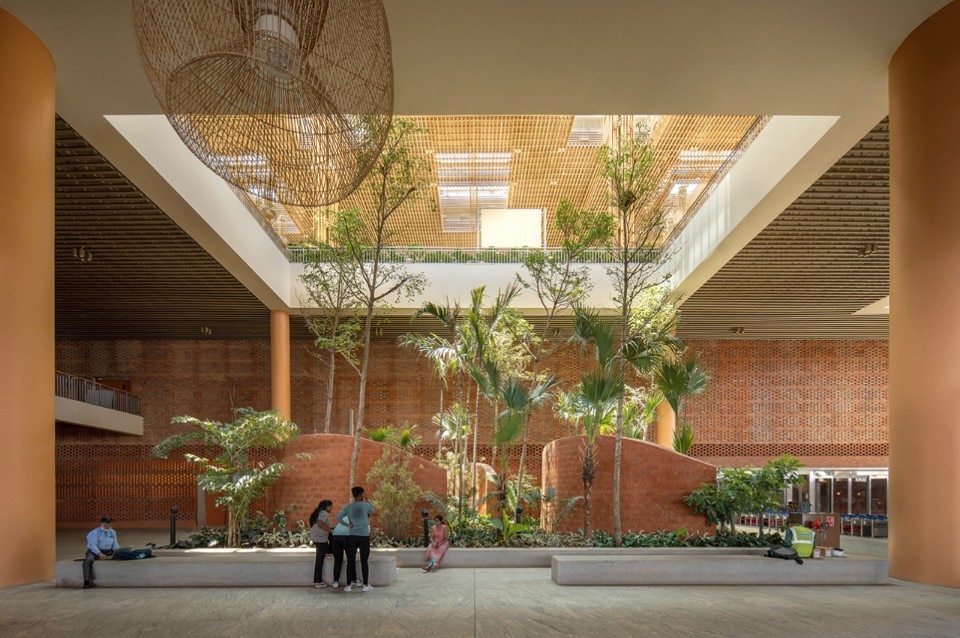
Green walls have been applied effectively in a number of terminals in recent years, such as our Terminal 3 at Changi. Planting beds add a refreshing grace note to the arrivals experience at CDG Hall L. The ceiling moss at Schiphol security screening was an amusing diversion. The circular gardens at the center of the satellite piers of Kuala Lumpur are impressively lush, but cannot be occupied by passengers – a visual experience only. Terminals 1 and 2 at Jakarta airport are perhaps the best example of landscape integration amongst the gate lounges as one could imagine for an earlier era that required less flexibility. There are even covered outdoor walkways to enjoy. The design of the Jakarta terminals draws a clear distinction between the building and the landscaped areas – no plantings are inside the gate lounges and the landside terminal is also devoid of nature.
An experience that calls on the senses of smell, touch and hearing.
Biophilia and wellness might not have been expressions at the time, but the benefits of nature were certainly taken for granted – as was the place-specific and national image that the design expressed. BIAL was well aware of these examples, but wanted a more immersive and complete experience, one that called on the senses of smell, touch and hearing. We had our work cut out for us.
The BIAL airport masterplan had been updated in the years prior to 2012. Terminal 2 was planned for a location east of Terminal 1, along the airport’s center axis, and in a position on the airport’s center axis. A second runway was to be constructed at the same time. The reference plan called for a traditional rectangular head house processor terminal with three piers projecting to the east – a kind of trident form.
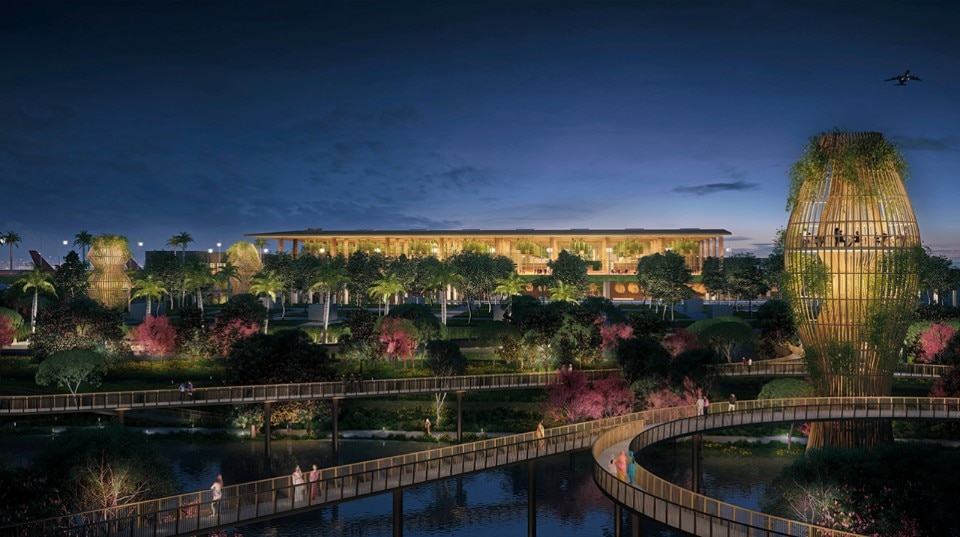
In addition to the theme of a ‘terminal in a garden,’ the Terminal 2 brief called for both domestic and international operations, adaptability, expandability, and the other operational, cost and service aspirations of clients aiming for optimum results. Our competition plan modified the trident plan into an X-shape form with four piers projecting on the diagonals. We addressed the nature/technology duality by forming the head house with a series of cross-wise partially glazed catenary vaults. Where the vaults met near were lavishly planted zones open to the exterior, with covered walks that allowed travelers to pass from one step in the process to the next. These transition zones reached to the ground and the arrivals level. Great boulders and waterfalls would have further marked these transition zones.
Following award, the planning slate was wiped clean and BIAL convened a series of brainstorming workshop retreats to canvass the best ideas for realizing the full promise of the garden theme. We then tested a wide range of plan forms – X-shape again, H-shape, I-shape, Y-shape (forward and backward), the Double Diamond, with two canted processors, and one we called Cross because its piers were perpendicular to the parallel and cross taxiways. Meanwhile, the DDFS was reassessed by BIAL’s planners and the gate count and mix adjusted. The terminal was to have a capacity of 25 MPPA in Phase 1 (10 MPPA International and 15 MPPA Domestic traffic). Phase 2 would take the terminal to a capacity of 40 MPPA, with whatever mix of International and Domestic traffic had developed at that time. A flexible plan was required.
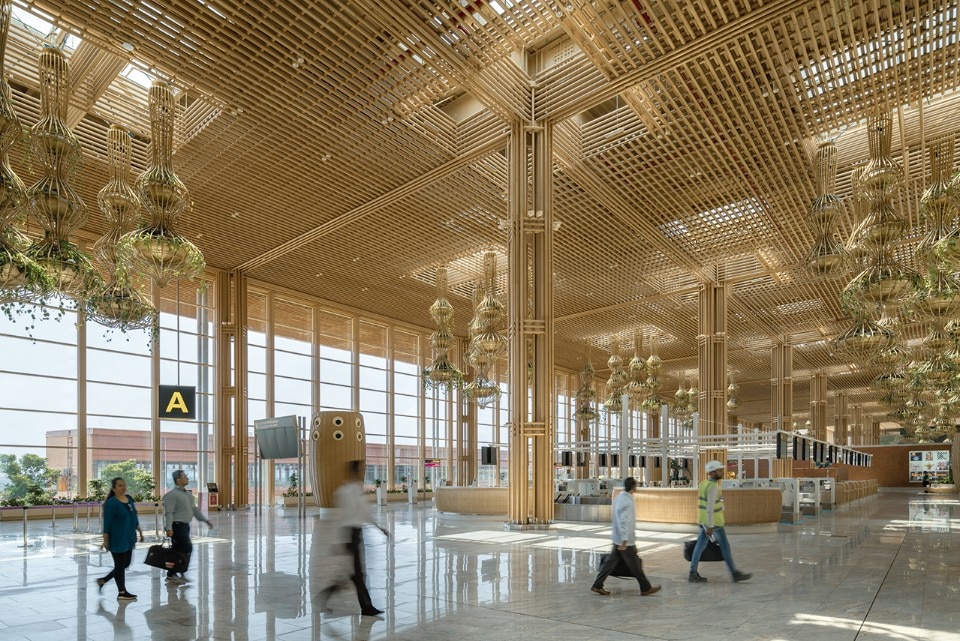
The head house size was also coming into focus based on those targets and the updated processor throughout rates – 55 check-in counters, 38 self check-in kiosks, 12 ATRS lanes. The required size of the processor was reducing in its width as BIAL applied more efficient technology. But the size of the concessions areas – the separate International and Domestic Departure Lounges – was growing to the extent where the combined width of these spaces equaled that of the head house.
We found that when we lined up the required 22 contact gates, they would fit along one side of a continuous single-loaded pier that could be folded along the perimeter of the terminal area and still leave room for push-back taxiways. The final step in the genesis of this unusual inverted, rectilinear C-shape plan was a direct result of finding a plan that met the required demand efficiently, but in doing so we happened on one that would allow the abundant development of landscaped garden.
The head house and departures lounge blocks could sit well inboard from the pier, separated by a 90-meter wide empty zone – a zone that would become the “forest belt” enveloping the terminal. The forest belt is lushly planted and dotted with fanciful structures – garden follies – that house coffee shops, restaurants and other amenities.
Departing and arriving passengers pass over the forest belt on covered but open air bridges. The forest belt wraps the entire perimeter of the head house and departures lounges and is visible from those spaces as well as the piers. Thus, the terminal appears to sit within a vast garden.
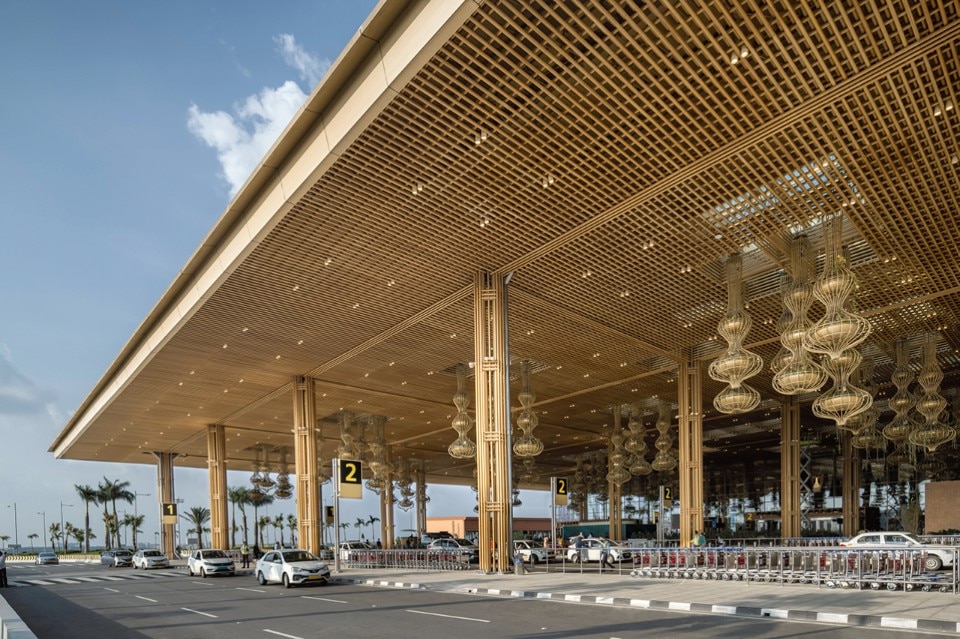
The continuous pier detached from the departure lounges block also facilitates a key aspect of the plan’s operational flexibility. While the international departures lounge occupies about two thirds of the block, and the domestic lounge the remaining third, the continuous pier can be progressively opened or closed to passengers from either lounge as traffic demands. A series of movable glass partitions in the pier allow, say, the number of international sector of gates be increased during the evening and nighttime, and conversely the number of gates serving domestic traffic during the daytime peaks.
This ‘swing’ capability increases gate utilization. This ‘swing’ capability extends to the arrivals corridors for the two sectors (which in the Indian aviation sector must remain segregated even from their own departures flows), the baggage reclaim hall, and of course check-in and security screening at departures.
The forest belt is lushly planted and dotted with fanciful structures – garden follies.
Passengers enjoy the interior and exterior landscape features as they journey through the terminal. The check-in hall is adorned by a realm of hanging baskets with exotic plants, many of them flowering, fed by a drip irrigation system and placed under skylights. This layer is located overhead so as not to impede the check-in queues and sightlines, or the long-term flexibility of the space.
A passage with green walls leads to security screening. Beyond lie the two departures lounges, the international one with the winding path through duty free shops. Each lounge has a fantastical array of plantings, fountains, and rock formations. Shops are provided along a street, and restaurants at an upper level or nestled in the greenery. They can also explore the forest belt, stopping at a resting place there or ascending one of the garden follies. Closer to flight departure time passengers move across the pedestrian bridges to the gate pier, which they find is also lushly adorned with interior plantings and exposed to the forest belt.
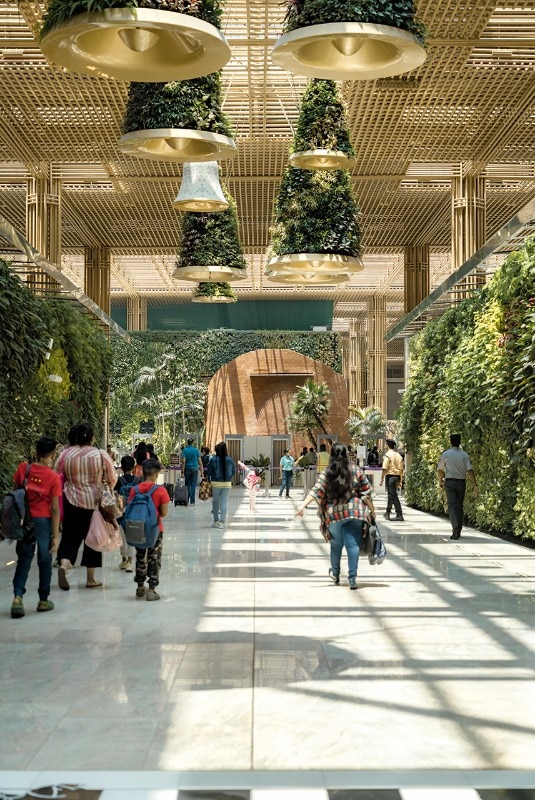
The corridors for arriving passengers are located just below the gate lounges and concourse, with an even closer view into the forest belt. The arrivals corridors that pass under the departures lounges from the eastern pier gates enjoy the gardens sunken from the floor of the departures lounges above. At the threshold of the immigration hall another transition is marked by landscape features. Only the baggage reclaim hall, which enjoys little direct daylight, is relatively sparsely planted.
Once exited from the terminal an extensive series of landside plazas was designed atop the parking and ground transport curbs, leading from the terminal exit to the Metro terminus. Pedestrian bridges lead to Terminal 1 and a future Terminal 3. This extensive environment is in construction now and will be an exterior complement to the terminal, but open to all as a destination and a place to meet and greet arriving passengers.
The technology aspect of the terminal’s character is, in the end, less evident. This is appropriate – processing technology should facilitate east passage and not be obtrusive. SOM and BIAL avoided large garish and ephemeral digital displays. The primary visual elements are natural, organic – the bricks locally produced, the stone quarried and worked near Bengaluru, and the engineered bamboo lattice formed around the lightweight structural steel frame of the departures level.
The Bengaluru client wanted, and I believe we and Grant Associates delivered, as end-to-end an experience as possible, given the aircraft safety and other constraints of an operating airport terminal. We feel the passenger journey warrants the term “immersive,” which is often applied in unintended exaggeration. Between the terminal and the forest belt there are almost 10,000 square meters of garden walls, 800 one-year old trees nurtured on-site ahead of the opening, 620 endemic plants and 7,700 transplanted ones. The terminal is, in the end, a new botanical garden for the “Garden City of India.”


